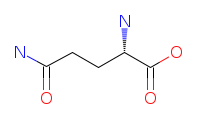Glutamine
Glutamine was first discovered by Schulze in 1883, who managed to isolate it from the beet juice. Later on, it turned out that glutamine can also be found in abundance in a wheat gliadin. Finally, in 1935, the synthesis of glutamine from ammonium and glutamate was explained and described by Krebs, who used the guinea pig and the rat kidney in his research.
Chemical Structure of L-Glutamine

Identifiers and properties of Glutamine
IUPAC Name: (2S)-2,5-Diamino-5-oxopentanoic acid
Symbol: Three-letter code - Gln. One-letter code - Q
Molecular Weight (Molar Mass): 146.1445 g/mol
Molecular Formula (Structural Formula): C5H10N2O3
Canonical SMILES: C(CC(=O)N)C(C(=O)O)N
Isomeric SMILES: C(CC(=O)N)[C@@H](C(=O)O)N
InChIKey Identifier: ZDXPYRJPNDTMRX-ISQTXBHGDW
CAS Number: 56-85-9
MDL Number: MFCD00008044
Melting point: 185 °C
RNA codons: CAA, CAG
Solubility in water: 35 g/L (20 °C); pKa - 2,17; pKb - 9,13
Rf value in n-butanol/acetic acid/water = 12:3:5 - 0.13
2D Molfile: Get the molfile
3D PDB file: Get the PDB file
Other names: L-Glutamic acid 5-amide; 2-Aminoglutaramic acid; L-2-Aminoglutaramidic acid; Glutamic acid amide; Glutamic acid 5-amide; gamma-Glutamine; Levoglutamid; Levoglutamide
What is the role of Glutamine?
Glutamine, also known as L-Glutamine, seems to be the most active amino acid involved in lots of metabolic processes. For example, glutamine is converted to glucose if your body needs more glucose as an energy source. Besides, it also participates in maintaining of a normal blood glucose level and the proper pH range. In fact, glutamine was recognized as the most abundant free amino acid found in the human muscles and in plasma. A human body utilizes this amino acid at high rates for rapidly dividing cells, like leucocytes, in order to supply them with an energy, i.e., to create the best conditions for the nucleotide biosynthesis. In other words, glutamine is considered to be vital for the proper immune function. When discussing the benefits of glutamine for women and men, it is important to note its role in muscle recovery and reducing soreness after workouts, making it particularly beneficial for athletes.
The major part of glutamine is stored in the muscles and in the lungs, where it is mostly produced. Glutamine is recognized as a very important amino acid helping removing excess ammonia, which is a usual waste product in the human body. This amino acid also turned out to be important for the digestion and for the normal brain function. Glutamine aids to protect the lining of the gastrointestinal tract and helps athletes to keep fit.
How is glutamine produced in the body?
The scientists have agreed that glutamine is the most abundant amino acid or the building block of a protein in the human body. But where can you get it from? Normally, your body can produce enough amino acid for its regular needs, but sometimes an extreme stress like a very intensive exercise or an illness may cause a shortage of glutamine because your body will need more amino acid than it can produce. People naturally are able to get enough glutamine without taking a supplement as the human body produces it. Besides, you can also get more glutamine in your diet. Meanwhile, some medical conditions like injuries, surgery, and stress usually lower the levels of this amino acid. As a matter of fact, when your body is stressed under such conditions, it releases the hormone called cortisol into your bloodstream. It's high levels of this hormone that lower the human body's stores of glutamine, implying that you may need to take a glutamine supplement to help your body to restore.
Food sources
As was written above Glutamine is a non-essential amino acid, meaning that the body can synthesize it on its own. However, it is also considered conditionally essential because there are situations, such as illness or intense physical exercise, where the demand for glutamine may exceed the body's ability to produce it.
Here are some food sources that contain glutamine.
Meat and Poultry. Chicken: A 3-ounce (85-gram) serving of roasted chicken breast contains approximately 1.7 grams of glutamine. Beef: Similar to chicken, a 3-ounce (85-gram) serving of beef provides around 1.7 grams of glutamine.
Fish. Salmon: A 3-ounce (85-gram) serving of cooked salmon contains about 2.5 grams of glutamine. Tuna: Tuna is also a good source of glutamine, with around 2.3 grams per 3-ounce (85-gram) serving.
Dairy Products. Milk: One cup of milk contains approximately 0.6 grams of glutamine. Yogurt: A typical serving of yogurt (about 6 ounces) provides around 1.5 grams of glutamine.
Eggs. One large egg contains roughly 0.6 grams of glutamine.
Legumes. Soybeans: A 1-cup serving of cooked soybeans contains approximately 1.6 grams of glutamine. Lentils: A 1-cup serving of cooked lentils provides around 1.3 grams of glutamine.
Nuts and Seeds. Almonds: A 1-ounce (28-gram) serving of almonds contains about 0.4 grams of glutamine. Sunflower Seeds: Sunflower seeds provide approximately 1.4 grams of glutamine per 1-ounce (28-gram) serving.
Dense Protein Sources. Whey Protein: One scoop (around 30 grams) of whey protein powder can provide 4-5 grams of glutamine
Animal Organs. Liver: Animal liver, such as beef liver, is rich in glutamine. A 3-ounce (85-gram) serving may contain around 2.5 grams of glutamine.
Cabbage Family Vegetables. Cabbage, Spinach, and Parsley: These vegetables are among the plant-based sources of glutamine. A 1-cup serving of cooked spinach contains approximately 0.4 grams of glutamine.
It's important to note that the glutamine content in foods can vary based on factors such as cooking methods and specific varieties. Additionally, while dietary sources contribute to overall glutamine intake, the body's synthesis of glutamine also plays a significant role in maintaining adequate levels. If you have specific health concerns or conditions that may require additional glutamine, it's advisable to consult with a healthcare professional or a registered dietitian for personalized advice.